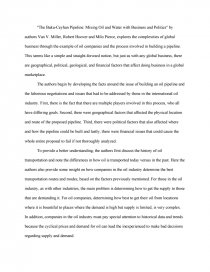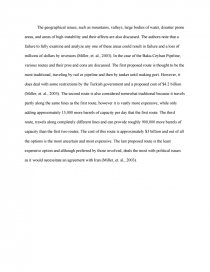The Baku-Ceyhan Pipeline: Mixing Oil and Water with Business and Politics
Essay by Paul • July 22, 2012 • Essay • 561 Words (3 Pages) • 1,913 Views
Essay Preview: The Baku-Ceyhan Pipeline: Mixing Oil and Water with Business and Politics
"The Baku-Ceyhan Pipeline: Mixing Oil and Water with Business and Politics" by authors Van V. Miller, Robert Hoover and Milo Pierce, explores the complexities of global business through the example of oil companies and the process involved in building a pipeline. This seems like a simple and straight-forward notion, but just as with any global business, there are geographical, political, geological, and financial factors that affect doing business in a global marketplace.
The authors begin by developing the facts around the issue of building an oil pipeline and the laborious negotiations and issues that had to be addressed by those in the international oil industry. First, there is the fact that there are multiple players involved in this process, who all have differing goals. Second, there were geographical factors that affected the physical location and route of the proposed pipeline. Third, there were political factors that also affected where and how the pipeline could be built and lastly, there were financial issues that could cause the whole entire proposal to fail if not thoroughly analyzed.
To provide a better understanding, the authors first discuss the history of oil transportation and note the differences in how oil is transported today versus in the past. Here the authors also provide some insight on how companies in the oil industry determine the best transportation routes and modes, based on the factors previously mentioned. For those in the oil industry, as with other industries, the main problem is determining how to get the supply to those that are demanding it. For oil companies, determining how best to get their oil from locations where it is bountiful to places where the demand is high but supply is limited, is very complex. In addition, companies in the oil industry must pay special attention to historical data and trends because the cyclical prices and demand for oil can lead the inexperienced to make bad decisions regarding supply and demand.
The geographical issues, such as mountains, valleys, large bodies of water, disaster prone areas, and areas of high instability and their affects are also discussed. The authors note that a failure to fully examine and analyze any one of these areas could result in failure and a loss of millions of dollars by investors (Miller, et. al., 2003). In the case of the Baku-Ceyhan Pipeline, various routes and their pros and cons are discussed. The first proposed route is thought to be the most traditional, traveling by rail or pipeline and then by tanker until making port. However, it does deal with some restrictions by the Turkish government and a proposed cost of $4.2 billion (Miller, et. al., 2003). The second route is also considered somewhat traditional because it travels partly along the same lines as the first route, however it is vastly more expensive, while only adding approximately 15,000 more barrels of capacity per day that the first route.
...
...

